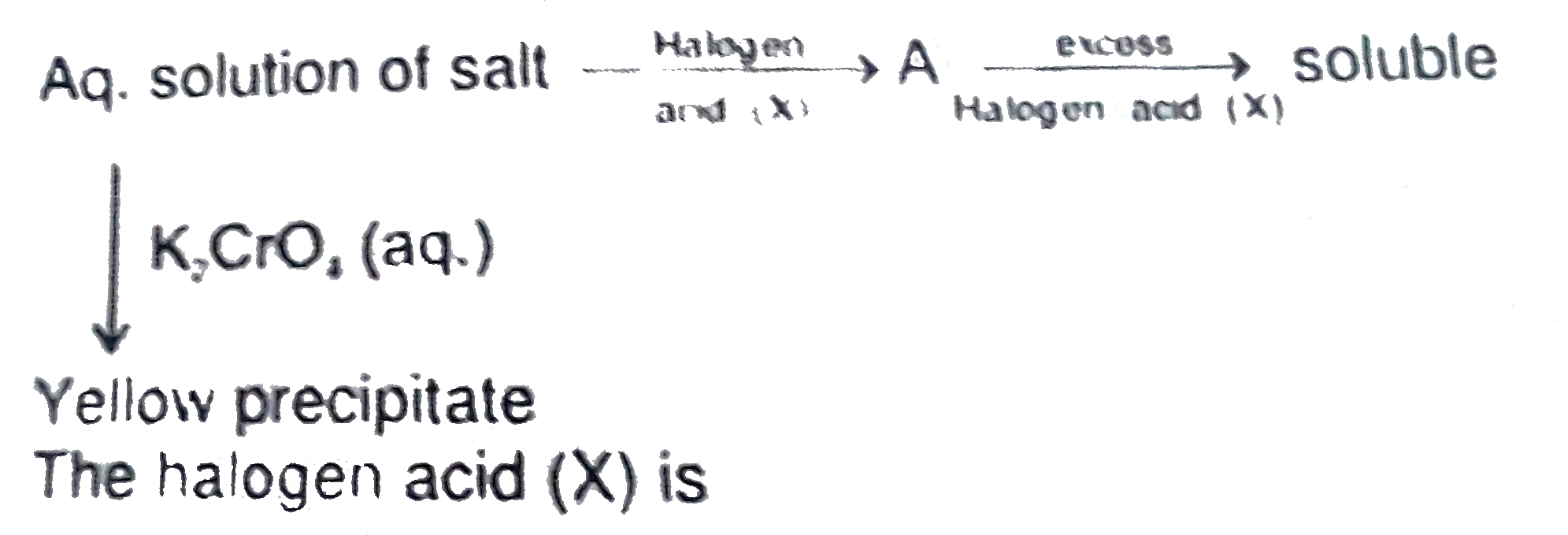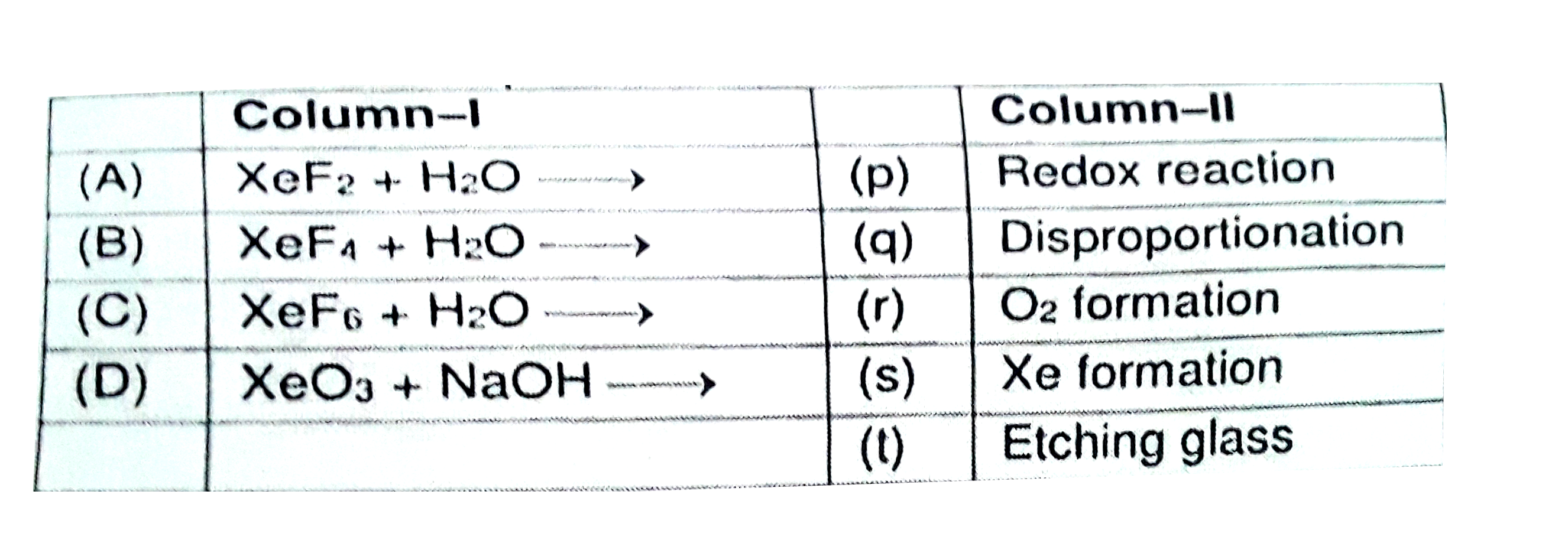Complete Solutions to APSP PART-3 of chapter P-BLOCK ELEMENTS (HALOGEN & NOBLE GASES) of Class 12 book with complete answers and questions
| Class 12 | CHEMISTRY |
| Chapter | P-BLOCK ELEMENTS (HALOGEN & NOBLE GASES) |
| RESONANCE NEW | APSP PART-3 |
| Number Of Questions | 22 |
| Academic Year | 2023-24 |
Which graph correctly describes a trend found in the halogen group ?
01:24View Solution(i)`(r)+(p)to NaClO_2 + O_2`
(ii)`IO_3^(-) + I^(-) overset(H^+)to (q)`
(iii)Acidic solution of `ClO_2^(-) to (s) + (r)` (disproportionation reaction )
(p)used as air purifier and `CO_2` absorber
(q) estimated by hypo and it forms violet colour vapour (it self)
(r)is yellow colour gas
(s) gives chromylchloride test.
which option is correct .View Solution`[HXeO_4]^(-) + OH^(-) to [X] + [Y] + O_2 +H_2O`
The products [X] and [Y] in unbalanced reaction are:01:04View SolutionConsider following properties of the noble gases.
I. They readily form compounds which are colourless.
II: They generally do not form ionic compounds.
III: Xenon has variable oxidation states in its compounds
IV : the smaller He and Ne do not form clathrate compounds.
Select correct properties.01:58View SolutionWhich behave like pseudohalide in following
01:18View Solution`Cl_2 (g) + Ba(OH)_2 to X (aq) + BaCl_2 + H_2O` ltbgt `X+ H_2SO_4 to Y + BaSO_4`
`Yunderset"365 K"oversetDeltatoZ + H_2O +O_2`
Y and Z are respectively :02:23View SolutionWhich of the following on treatment with `XeF_6`gives Xe ?
01:24View SolutionWhich of the following have melting point less than 298 K
01:12View Solution
The halogen acid (X) isView SolutionSelect the correct statement
02:22View SolutionWhich of the following are Pseudo halid
00:55View SolutionWhich of the following can be obtained by hydrolysis of `XeF_6`
01:35View SolutionWhat is the sum of group number and period number (according to IUPAC system ) of the non-metal which exist in liquid state at room temperature
01:23View SolutionHow many of the following compounds from HCl on hydrolysis as one of the products (major or minor)
(i)`BCl_3` , (ii)`BiCl_3` , (iii)`SO_2Cl_2` (iv)`NCl_3` (v)`PCl_5` (vi)`CrO_2Cl_2` (vii)`CH_3Cl` (viii)NaCl01:14View Solution`NH_4ClO_4 + NHO_3 to (A) + (B) oversetDeltato (C )` (neutral oxide)
The summation of number of lone pairs and atomicities of compound B and C is .View SolutionThe oxidation state of iodine in compound which is obtained by heating `HIO_3` at `170^@C` is +n.
Give value of n00:56View SolutionHydrolysis of compound A , two acids P and Q forms, P is used in etching of glass, Q on strongly heating gives a oxide R. R is used in estimation of carbon monoxide . Calculate total number of lone pairs on compound A .
02:11View SolutionThe simplest ratio x:y of xenon and fluorine when passes through Ni-tube `(400^@C)` at high pressure gives `XeF_6`. Here x+y is :
01:20View SolutionWhite crystalline solid (A) reacts with `H_2` to form a highly associated liquid (B) and a monoatomic , colourless gas (C ). The liquid (B) is used for etching glass. Compound (A) undergoes hydrolysis slowly to form (C ), (B) and a diatomic gas (D ) whose IE is almost similar to that of (C ). (B) forms an addition compound with KF to form (E) which is electrolysed in the molten state to form a most reactive gas (F) which combines with (C ) in 2:1 ratio of produce (A).
According to Molecular Orbital Theory, which of the following is correct about the molecule (D) ?01:18View SolutionWhite crystalline solid (A) reacts with `H_2` to form a highly associated liquid (B) and a monoatomic , colourless gas (C ). The liquid (B) is used for etching glass. Compound (A) undergoes hydrolysis slowly to form (C ), (B) and a diatomic gas (D ) whose IE is almost similar to that of (C ). (B) forms an addition compound with KF to form (E) which is electrolysed in the molten state to form a most reactive gas (F) which combines with (C ) in 2:1 ratio of produce (A).
Which of the following is correct for the white crystalline solid (A) ?01:16View SolutionWhite crystalline solid (A) reacts with `H_2` to form a highly associated liquid (B) and a monoatomic , colourless gas (C ). The liquid (B) is used for etching glass. Compound (A) undergoes hydrolysis slowly to form (C ), (B) and a diatomic gas (D ) whose IE is almost similar to that of (C ). (B) forms an addition compound with KF to form (E) which is electrolysed in the molten state to form a most reactive gas (F) which combines with (C ) in 2:1 ratio of produce (A).
The compound 'A' reacts with sulphur to form a compound in which hybridisation state of sulphur atom is :04:14View SolutionMatch the reaction products listed in column-I with the particulars listed in column-II
 02:38View Solution
02:38View Solution
APSP PART-3 questions and complete solutions for chapter P-BLOCK ELEMENTS (HALOGEN & NOBLE GASES) of PHYSICAL, INORGANIC, AND ORGANIC CHEMISTRY of Class 12
